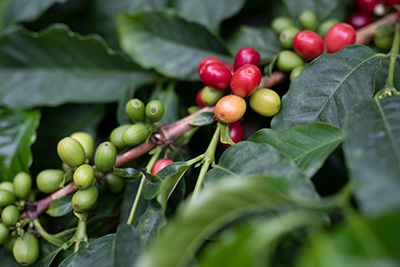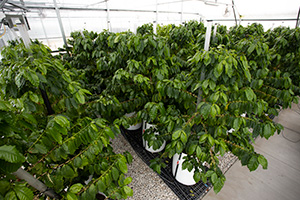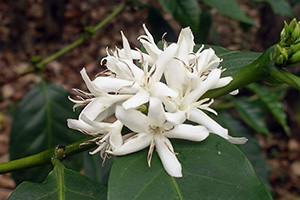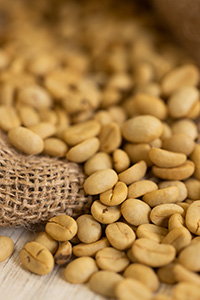Coffee
Coffee is a major horticultural crop that is grown in over 80 countries around the world.

The two main species are arabica (Coffea arabica) and robusta (Coffea canephora). Both are in the Rubiaceae family and are related to common garden plants such as ixora, gardenia and pentas.
Although coffee is typically grown in tropical regions with high elevation, it can also be grown in the southernmost parts of Florida. The small, attractive trees feature tiny fragrant flowers, shiny green foliage and of course, the red fruits from which we process coffee beans.
Not only is this plant desirable for its aromatic beans, it works in the landscape as a specimen plant or small understory tree in wooded areas. Coffee is also an emerging commercial crop in Florida, although it is still considered to be experimental.
If you’d like to grow this beautiful bush and even roast your own coffee beans, then read on.
Characteristics

Coffee trees can reach heights of up to 50 feet, but they are typically pruned to be 4 to 6 feet tall in the home landscape for practical reasons. The leaves are dark green and ovate with prominent veins and rippled margins. In the spring, the white, five-petaled flowers appear in clusters along the stem. The flowers of the arabica species are self-fertile, which means they don’t require cross-pollination to bear fruit. Conversely, robusta flowers do require cross-pollination. Arabica plants will grow true to type from seed, but robusta plants (and hybrids) often don’t.
The flowers lead to bright red drupes called “cherries.” Within the fruits are two seeds that look just like the whole coffee beans you buy at the store, except they are much paler and tend to have a green or yellow hue.
Planting and Care
When choosing which type of coffee to plant, it is best to consider their adaptability. Studies from UF/IFAS researchers have demonstrated that arabica production is expected to decline by 2050 due to the warming climate; however, they find that robusta is a great alternative. Robusta not only tastes great, it’s more sustainable; it’s better adapted to fluctuating environmental conditions and is lower maintenance than arabica. While either arabica or robusta can be grown in the South Florida home landscape, if you want to lessen your impact on the environment and maximize your coffee bean production, then robusta is the better option.

Coffee will grow best in zones 10B through 11, although it can potentially be grown further north with the right microclimate. There are many cultivars and hybrids, but the plants you’ll find at nurseries will likely only be labeled as either “arabica” or “robusta.” Look for healthy trees that are in 1- to 3-gallon containers, with the tree being 2 to 4 feet tall. Large trees in small containers tend to be root-bound. If buying robusta, you will need two plants so they can cross-pollinate.
Coffee naturally grows as an understory plant, so it is typically planted in areas with light shade. Production will be higher if you grow it in a sunny location, but it will need more water and fertilizer to thrive. The ideal conditions are temperatures between 59 to 75 degrees Fahrenheit, high humidity and protection from windy conditions. Coffee does not tolerate freezing temperatures.
For best results, choose a planting location with rich, well-drained soil. The soil’s pH should be slightly acidic to neutral, although with good drainage, coffee can tolerate soils with a higher pH. It should be planted in the warmest part of the landscape that does not flood during summer rains. If you are planting near trees, buildings or structures, make sure there is at least 8 feet between them and the plant. Our article on Planting and Establishing Shrubs goes into more detail.
Applying mulch to your coffee plants can help conserve moisture, reduce weed problems and improve the soil composition. Apply a 2- to 6-inch layer of bark, wood chips or other natural mulch. Preserve a mulch-free zone within 8 to 12 inches of the trunk. Also, keep grass at least two feet away from the trunk since lawn equipment can damage coffee plants. Lawn sprinkler systems can result in overwatering of the coffee plant, causing root rot. Heavy lawn fertilization nearby can reduce fruit quality and production.
Coffee plants require a specific irrigation, fertilization and pruning schedule. The Ask IFAS publication “Coffee Growing in the Florida Home Landscape” has a handy table to help you keep track of maintenance throughout the year.
Pest problems you may encounter include stem borers, leaf miners, mealy-bugs, scales and mites. Potential disease issues include several fungi, but growing coffee in an ecologically healthy landscape or food forest prevents this most of the time. Keep in mind that pest problems could become more prevalent if coffee becomes a larger-scale crop in Florida.
If you see symptoms of pest or disease problems, contact the experts at your county Extension office for guidance.

Preparing the Beans
Once your coffee cherries have turned from green to red, they are ready to harvest! After picking them, rinse them in clean water and discard any berries that float. The ones that sink are good and those that float are not. Then, peel the cherries and remove the outer pulp. Soak the cleaned beans in water for 24 hours to allow them to ferment. Next, wash them again and spread them out on paper in the sun to dry. You’ll know the beans are done drying when you can remove the outer layer (called the hull) by rubbing.
The last step is to roast your beans. There are many ways to do this, from using your stovetop, to baking in your oven, to investing in a coffee roasting machine. Contact the family and consumer sciences agent at your local county Extension office for roasting advice.
Coffee is a desired plant across the world, and it can be grown right here in the Sunshine State. There is nothing like the beans produced by this small tree, and growing them in your backyard could be an interesting and fruitful experience. Coffee might become a commercial crop in Florida in the future, so check back with UF/IFAS for updates.
